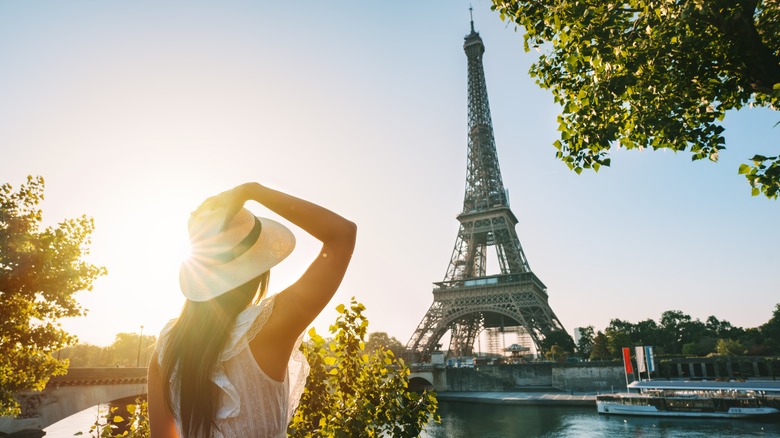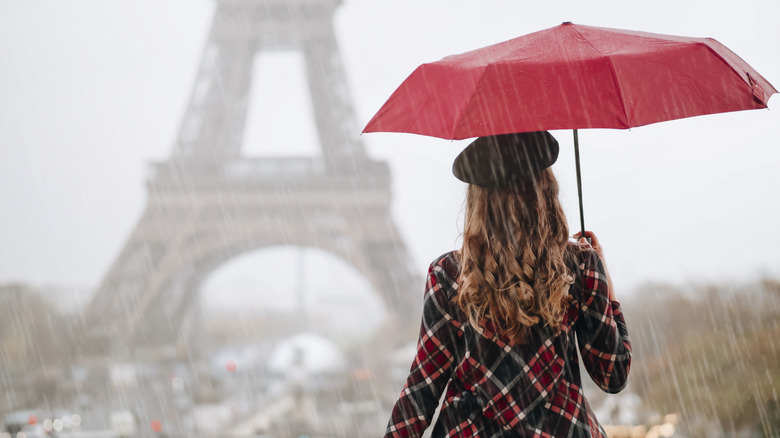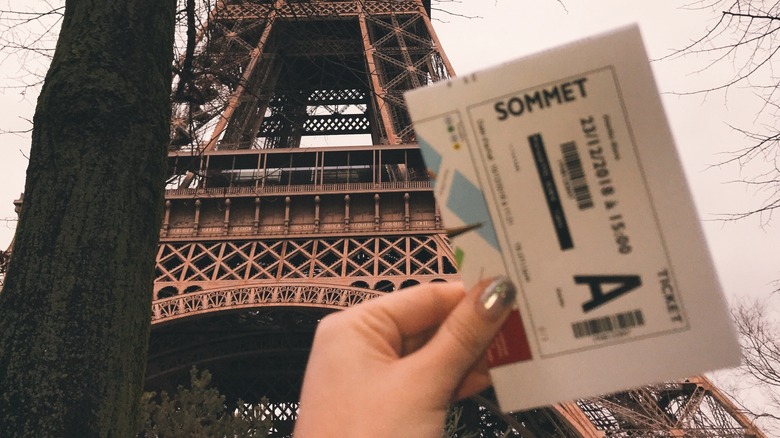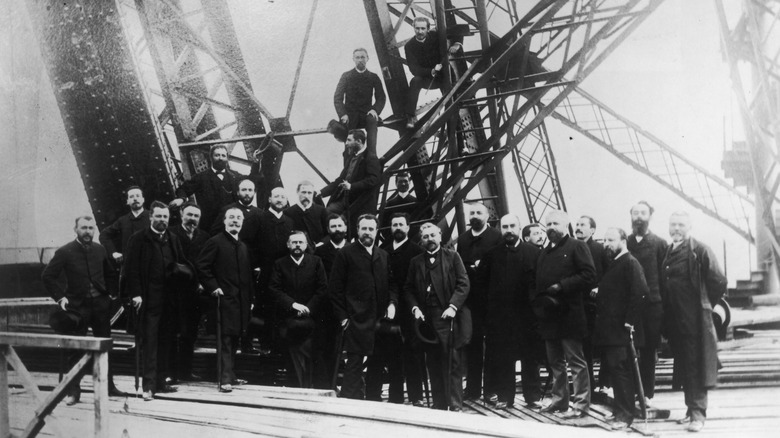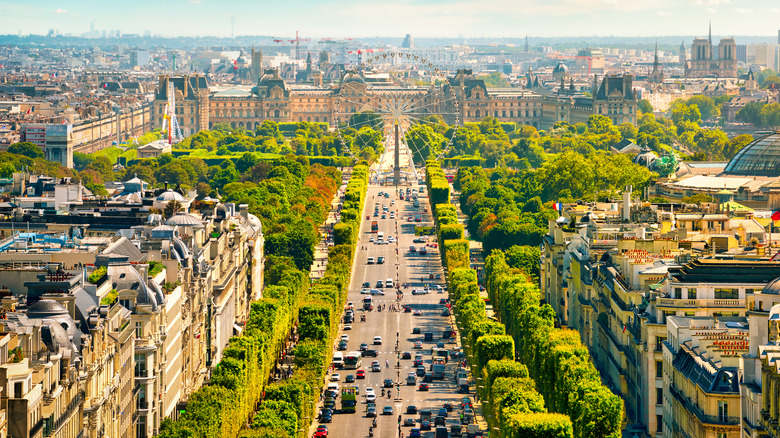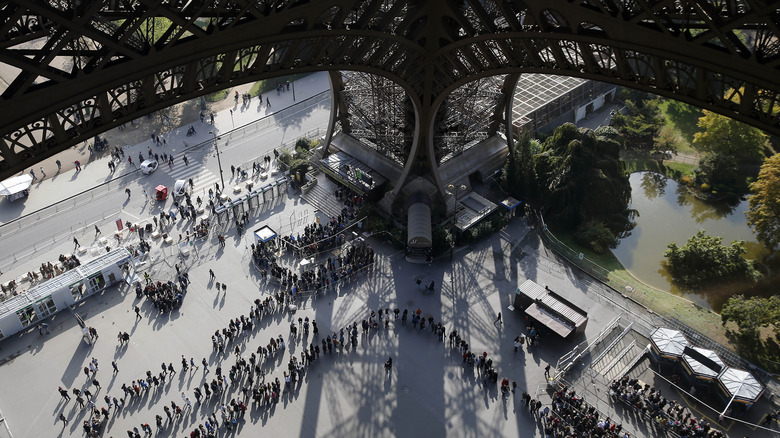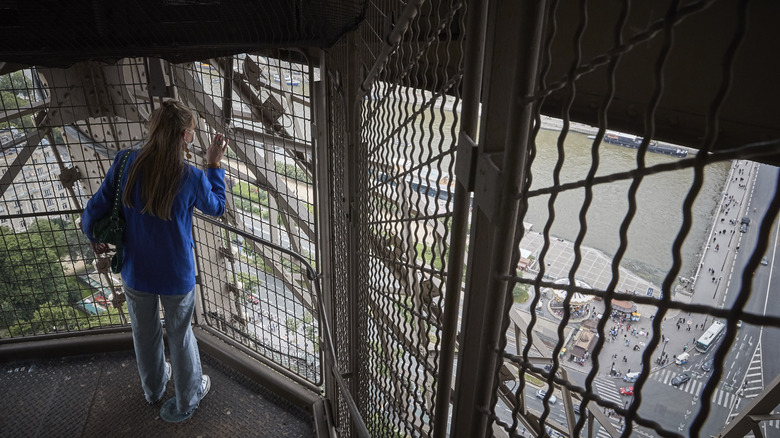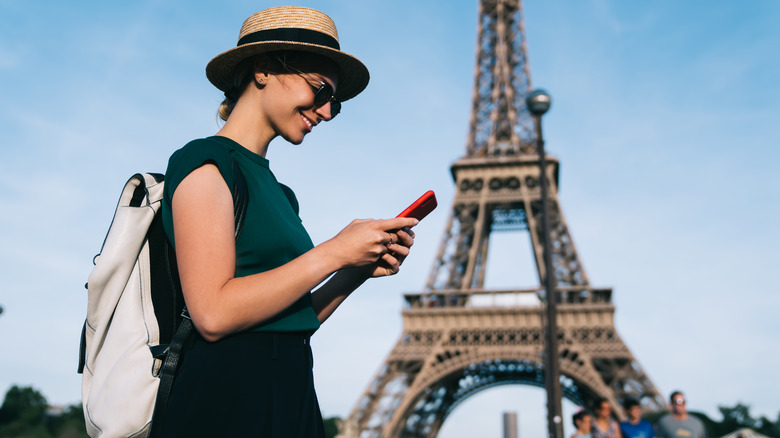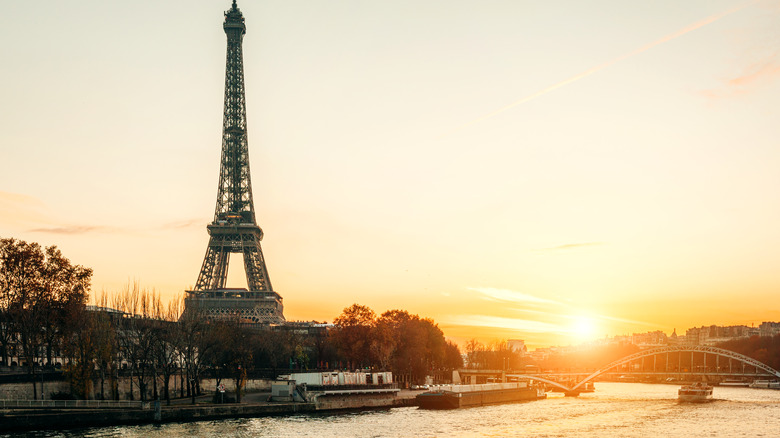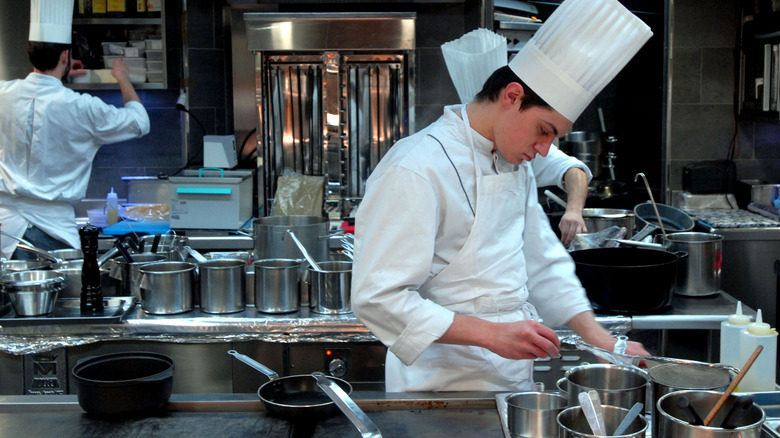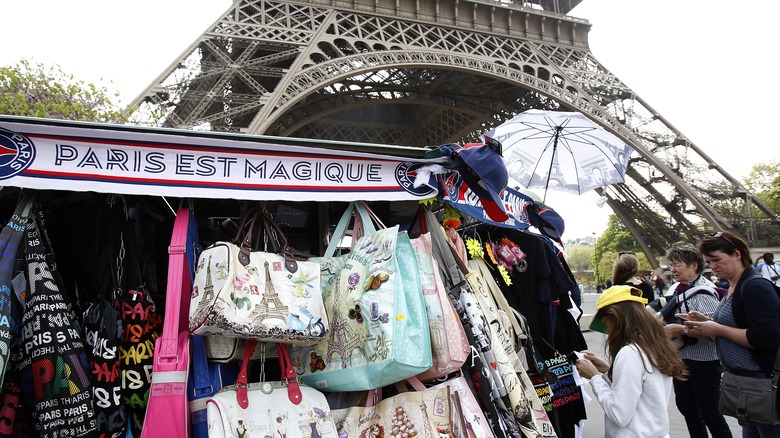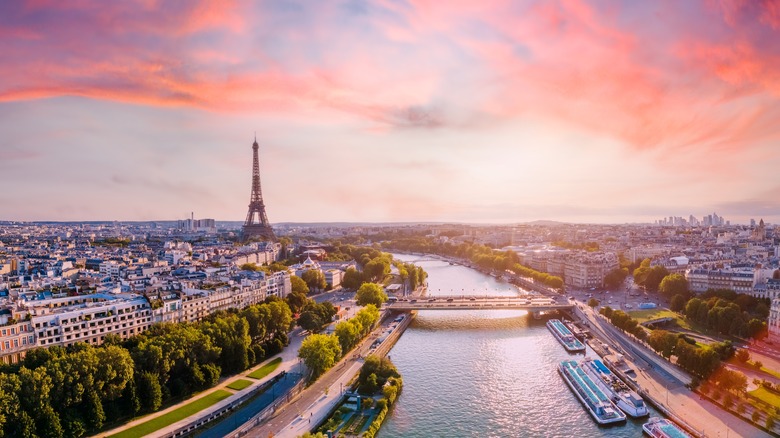11 Things To Know Before Visiting The Eiffel Tower
The Eiffel Tower may be the perfect national monument. It's elegant and symmetrical, and on a clear day, its 1,083-foot peak is visible from miles away. In a city of wide boulevards and cream-colored apartment buildings, the Eiffel Tower literally sticks out of the skyline like a sweeping steampunk pyramid. Completed in 1889, La Tour Eiffel is actually one of the younger structures in central Paris, yet it's come to symbolize all things French.
Travelers to France are all but obligated to ascend the tower and take a selfie on its topmost observation platform. Luckily, the Eiffel Tower is pretty easy to visit: It stands in the geographic heart of Paris, and the structure is open to the public every day of the year. Tickets aren't cheap, but they're definitely affordable (and less expensive for minors). You don't need any special permit or guide to get there; you can just walk right up to the entrance. Like the Statue of Liberty — another masterpiece that Gustave Eiffel helped build — the Eiffel Tower is designed for everyone to enjoy.
That said, a little planning goes a long way, especially if you want to experience the city like a Parisian. Paris is one of the most popular destinations in the world, and tourists flock to the tower the minute it opens. If this is your first time visiting, here are a few things to know for the best experience of this architectural wonder.
The weather doesn't always cooperate
Just about every postcard and Instagram post shows the Eiffel Tower on a sunny day, standing attractively beneath a summery blue sky. The tower is also lit up after sunset, which makes for a spectacular landscape on clear nights.
But the weather in Paris is much more finicky than many first-timers realize. It's very much a four-season city, and many North Americans are surprised to learn that it's farther north than many major cities in Canada. Rainstorms can pass through any day of the year, and the sky is often overcast (or even foggy). A misty day can ruin the view that visitors yearn for. In contrast, summers in Paris can be punishingly hot, and standing in crowds can be a sticky experience. The staircase is also open-air, and although you probably won't get directly rained on as you take the steps, there's no climate control to protect you from outside temperatures. Finally, some folks may struggle on windy days, especially if they're already nervous about heights.
The good news is that the Eiffel Tower almost never closes for an entire day, so if the weather doesn't cooperate when you visit, it just might the next day. If you're planning a trip to Paris, many people recommend visiting in the spring or fall when tourism is less congested and the weather is generally temperate and comfortable.
Reservations are recommended
To ensure a successful trip, you can easily purchase entry tickets in advance from the Eiffel Tower website, and there are several options to choose from. You can go straight to the top, of course, or you can just head to the second floor, which is at a still-impressive 377 feet above ground level. You can also arrange a guided tour or request a glass of champagne when you arrive.
No matter how you decide to organize your visit, reserving in advance is a smart idea. Lines form in front of the official ticket booth before the monument even opens, and admission often sells out during the high season. You may also be able to reserve your spot through your hotel or tour operator. Just make sure you secure e-tickets from a reputable service, as most major monuments attract scammers.
If you plan to have a sit-down meal at the Eiffel Tower, you should definitely reserve your table as well. Getting seated at the tower's two restaurants, Madame Brasserie and Le Jules Verne, can be a competitive experience, especially in the high season and around holidays.
Learn the Eiffel Tower's history
Did you know that the Eiffel Tower is built out of iron, not steel? Were you aware it was constructed as a centerpiece for the 1889 World's Fair? Perhaps you know the name Gustave Eiffel, the mastermind behind the monument, but did you know he collaborated with 50 additional engineers and designers? Would you believe the surface is covered in 60 metric tons of paint?
Most people recognize the Eiffel Tower and could draw a rough picture of it if they had to, but tourists don't necessarily know about its unlikely design and construction, nor about the controversy that haunted the tower even before the foundations were dug. There are numerous books about the Eiffel Tower, biographies of Gustave Eiffel, and histories of the Belle Époque, the period of prosperity and urban renewal that led up to this architectural experiment.
To fully appreciate your visit, you may first want to read one of these books or watch a documentary, especially if you're traveling without a tour group. Professional guides will recount the history and point out every notable detail, and once you reach the top, you can also peer into a replica of the creator's office, complete with wax sculptures of Eiffel, his daughter, and Thomas Edison. But aside from some projections and displayed documents, the Eiffel Tower isn't exactly a "museum," so the more you learn ahead of time, the more you'll understand what you're looking at.
Driving can be a pain
Driving in the center of Paris has never been fun. Yes, the streets are usually wide, but drivers can be cavalier, and some areas — such as around the Arc de Triomphe — are pure anarchy, with no painted lines and manic lane-changing. Competitive parking and the addition of more bicycle lanes have made the act of driving even more unpleasant, especially for foreigners trying to puzzle out French signage. The Eiffel Tower stands right in the middle of this headache.
Luckily, Paris is renowned for its public transportation. The Métro can carry you all over the city, and the closest station is Champ de Mars, which is a quick and beautiful walk from the tower. Paris is packed with traditional taxis and ride-share options, so you can easily hitch a ride from a downtown hotel. On nicer days, you might also consider borrowing a bicycle through the Vélib' Métropole bike-sharing system. Cycling is a wonderful way to get around, especially in the inner city, and about a third of these machines are electric bikes.
But really, Paris is one of the best cities in the world to just walk around. The wide sidewalks, sprawling public parks, and walkways along the River Seine have inspired visitors for generations. The Eiffel Tower is so easy to spot and so attractive from any angle, you may find yourself taking longer to get there because of all the photo ops.
The lines can get long
Paris is a vacation hotspot, and the Eiffel Tower is one of its main attractions, alongside the Louvre, Notre Dame Cathedral, and the Pompidou Center. The tower attracts 7 million visitors each year, for an average of about 19,000 per day. Some days are busier than others, of course, but you can expect quite the mob. So, if you're looking for a place in Paris not overrun with tourists, this might not be the spot for you.
Nearly everyone wants to make their way to the top, and most of them will do it by elevator. You should budget several hours for your visit and plan accordingly. There are definite perks to waiting around at the Eiffel Tower: Most tourists are excited to be there and hail from all over the world, and an estimated three-quarters of them don't come from France at all, so there should be a good chance of small talk with fellow travelers. Meanwhile, if you don't have cell service, the Eiffel Tower has its own free Wi-Fi, allowing you to log on and tinker with a favorite app while you're standing around.
Inevitably, all the waiting will take its toll on your bladder. The Eiffel Tower has free restrooms on each of its three "floors," so you shouldn't have to wait forever for relief. Visitors are also permitted to bring water and snacks, which should keep your blood sugar balanced during the long waits to get up or down.
It's worth taking the stairs
The elevators in the Eiffel Tower are as old as the building itself, and you can imagine what a science-fiction experience it was to ride a special car to the top of the world's tallest human-made structure back in 1889. Elevators aren't quite as special as they used to be, but they now represent mobility and accessibility. In theory, just about anyone can enjoy the views from the top of the Eiffel Tower. In short, taking the elevator isn't "cheating," and it's the only way for visitors to reach the top.
But you're also welcome to take the stairs as far as the second floor, and if you like or prefer a workout in your tourist experience, the staircases may be worth taking. First, you get to avoid some of the crowd. Second, you can admire even more closely the tower's groundbreaking engineering. You can examine the rivets and iron sheets, the girders, and spiral staircases. If you're going up, you can watch the ground recede beneath you and the pedestrians in the park shrinking into dolls and then ants. Once you reach the last of those 674 steps, you can celebrate your victory with an impressive view. You can also replenish calories at the buffet.
Another option is to take the elevator to the second floor and take the stairs down to the street level. This is much easier on the thighs, and you still get to explore the superstructure from within.
There's an app for that!
Yes, the Eiffel Tower has its own app, available in French, English, Spanish, and Chinese. This may seem like overkill for a one-time visit, but the app is easy to navigate and attractively put together. The maps are its most useful features, directing visitors to shops, restaurants, and facilities. The app is cleverly designed so that tapping the up arrow will take you higher in the building, and tapping the right or left arrows will take you into the surrounding gardens. The best part of the app is that it's free, and you don't have to download anything; it functions like a regular website and adapts to any device.
The app is especially handy if you aren't taking a guided tour and haven't read much about the Eiffel Tower beforehand. From the moment you step on the esplanade, the app points out notable sights that you might not have spotted yourself, such as the frieze etched with the names of 72 scientists and innovators. If you've done a little homework, the app also has a quiz for testing your knowledge. Regardless of when you visit the tower, you can scope out the 360-degree "virtual panorama" from the top.
The best times to visit are morning and evening
The Eiffel Tower opens almost every day at 9:30 a.m., and the early bird is usually rewarded with shorter lines and peppier company. This leaves you plenty of time to grab a croissant and coffee at the patisserie and maybe take a walk through the grounds of the Champ de Mars before you join the line for the elevator.
The tower gets increasingly busy through midday and afternoon, but the crowd usually thins out again in the evenings. For a very different view of Paris, the Eiffel Tower's summit is a great place to visit after nightfall, when the surrounding arrondissements are lit up and illuminated boats float their way down the Seine. The tower itself sparkles with 20,000 bulbs. They don't call it "The City of Light" for nothing.
There's another reason to visit during these times, especially if you like to take pictures: Sunrises and sunsets over the city's horizon can be awe-inspiring from the first, second, or top floors, making for colorful landscapes and "pano" shots. Videographers can also experiment with time lapses when the sky is dynamic and headlights show traffic speeding along the boulevards. Warmer months are more comfortable since most of the tower is outdoors, but if you bring proper seasonal clothing, cold-weather visits offer the same vistas with a fraction of the foot traffic. Indeed, winter is an unexpectedly great time to visit Paris.
You can eat there
French cuisine is renowned throughout the world, and Paris is its epicenter. Naturally, the Eiffel Tower has not one but several eateries, catering to different palettes and income brackets. The easiest spots are the grab-and-go buffets, which require no reservations and are in three different locations: on the esplanade, first, and second floors. If you just need a quick sandwich and a drink to satisfy your appetite, this is the place.
On the first floor is Madame Brasserie, a cozy restaurant with beautiful views and elegant meals by Chef Thierry Marx. One floor above that is the Michelin-starred, ultra-chic Jules Verne, with its even higher views and an haute-cuisine menu by Chef Frédéric Anton. At the top of the Eiffel Tower is a champagne bar, featuring macarons from the macaron bar on level 2. Bubbly is, of course, one of France's greatest gifts to the world, and true macarons melt in your mouth like a sugary puffball. If your budget allows, treat yourself to drinks and dessert 1,000 feet above the city.
There's a (pricey) gift shop
Some jet-setters fly to France just to browse the stores, and faire du shopping is one of the great Parisian pastimes. There are seven gift shops within the Eiffel Tower, all on the esplanade, first, and second floors. "I got this for you at the Eiffel Tower" is a phrase with a lot of cachet, especially when that gift is something one-of-a-kind, like a limited-edition rivet made from authentic Eiffel Tower iron. Many of these unique items are made by local merchants, such as Kerzon's scented candles and upcycled sneakers from Le Lissier.
Just a word of advice: Quite a few of the other items in these gift shops are fairly generic, and equivalent versions can be found in almost any souvenir shop in Paris. Snow globes and decorative models are cute and all, but they may look a lot more appealing on the shelf of a famous monument than they will on your credit card bill. This is typical of any major tourist attraction: The closer you get to the place, the pricier the knickknacks. When it comes to novelty mugs and blank books, it's okay to shop around.
There's a lot else to see
The Eiffel Tower rises so high above the city that visitors don't always realize how close it is to other sights. Directly around the tower stands an elegant vintage carousel, the expertly groomed gardens of the Champ de Mars, and exhibits of indigenous artwork at the Musée du quai Branly. Stroll across the Pont d'Iéna bridge, and you'll find the expansive Trocadéro Gardens, or the Paris Aquarium, or the halls of natural history at the Musée de l'Homme. The Eiffel Tower is smartly located in the middle of the action, and all you need is a pair of shoes and a handful of euros to enjoy them.
One of the great terms in French is the flâneur, which usually translates as "one who strolls." For hundreds of years, some of the most famous artists, writers, and philosophers have meandered through Paris with no destination in mind, taking their time on meals, espressos, and glasses of wine. Aside from its walkability, the center of Paris is fairly compact, so a visit to the Eiffel Tower can easily be coupled with other experiences. As actor Audrey Hepburn once put it, "Paris is always a good idea."
